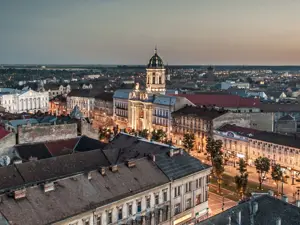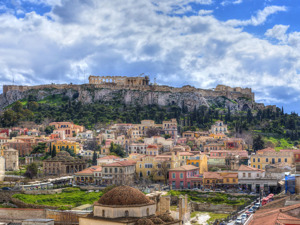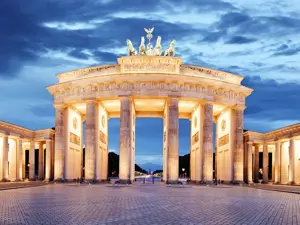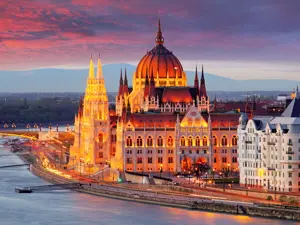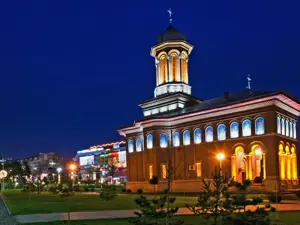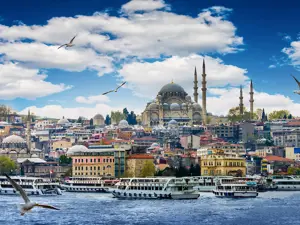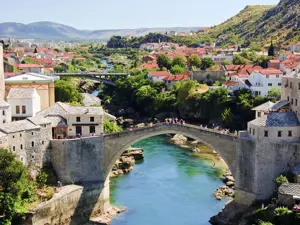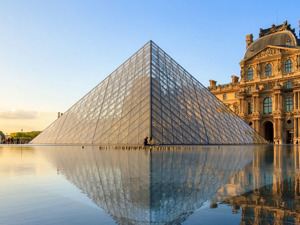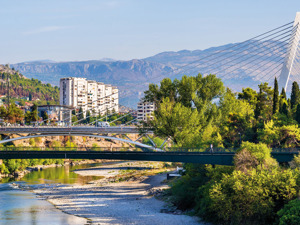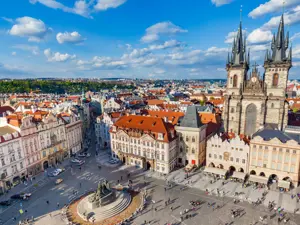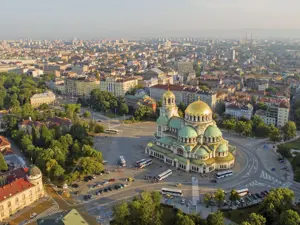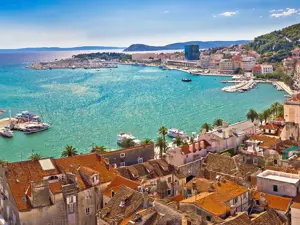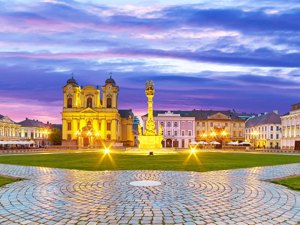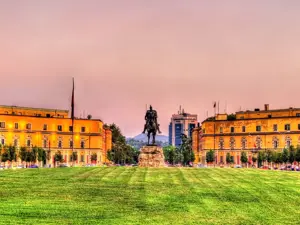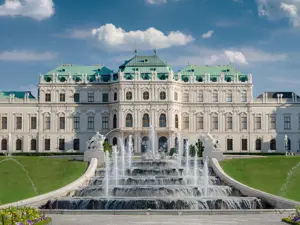The Gateway to the Balkans
Belgrade, the capital of Serbia, is one of Europe's oldest cities, built at the confluence of two important rivers: the Sava and the Danube, spanned by the Brankov Bridge. Known as the "Gateway to the Balkans" or the "Gateway to Central Europe," the city boasts a millennia-long history. Throughout the centuries, it has been influenced by various peoples, including the Celts (who founded the present-day city in the 3rd century under the name Singidunum), Romans, Slavs, Hungarians, Turks, and Austrians, all of whom have left their marks on Belgrade's cultural life, diverse architectures, and historical monuments.
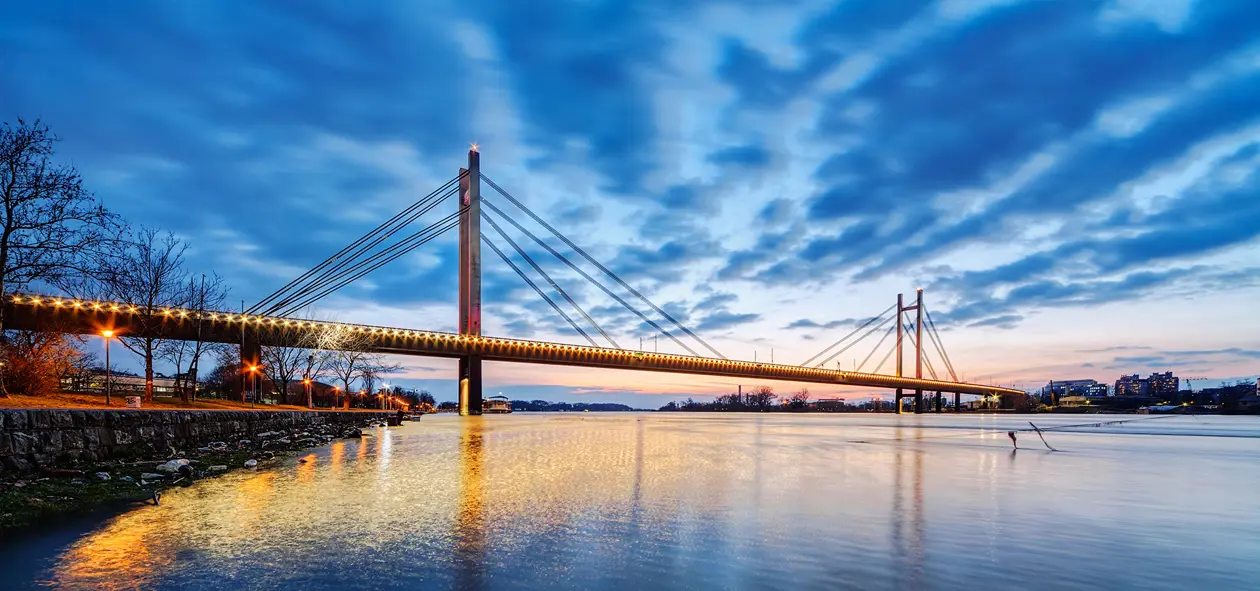
Visiting the city of Belgrade is a journey back in time, immersing oneself in Serbian culture and its rich history from ancient origins to modern times. At first glance, the Belgrade Fortress (Kalemegdan) is striking - the city's iconic site towering from a hilltop, overlooking the confluence of the Danube and Sava rivers. It's an imposing historical structure, built between the 1st and 18th centuries, offering breathtaking views of the city, ancient walls, museums (the Military Museum and the Natural History Museum), Ruzica Church, and St. Paraskeva Church (Sveta Petka), along with Kalemegdan Park and the Pobednik (The Victor) monument.
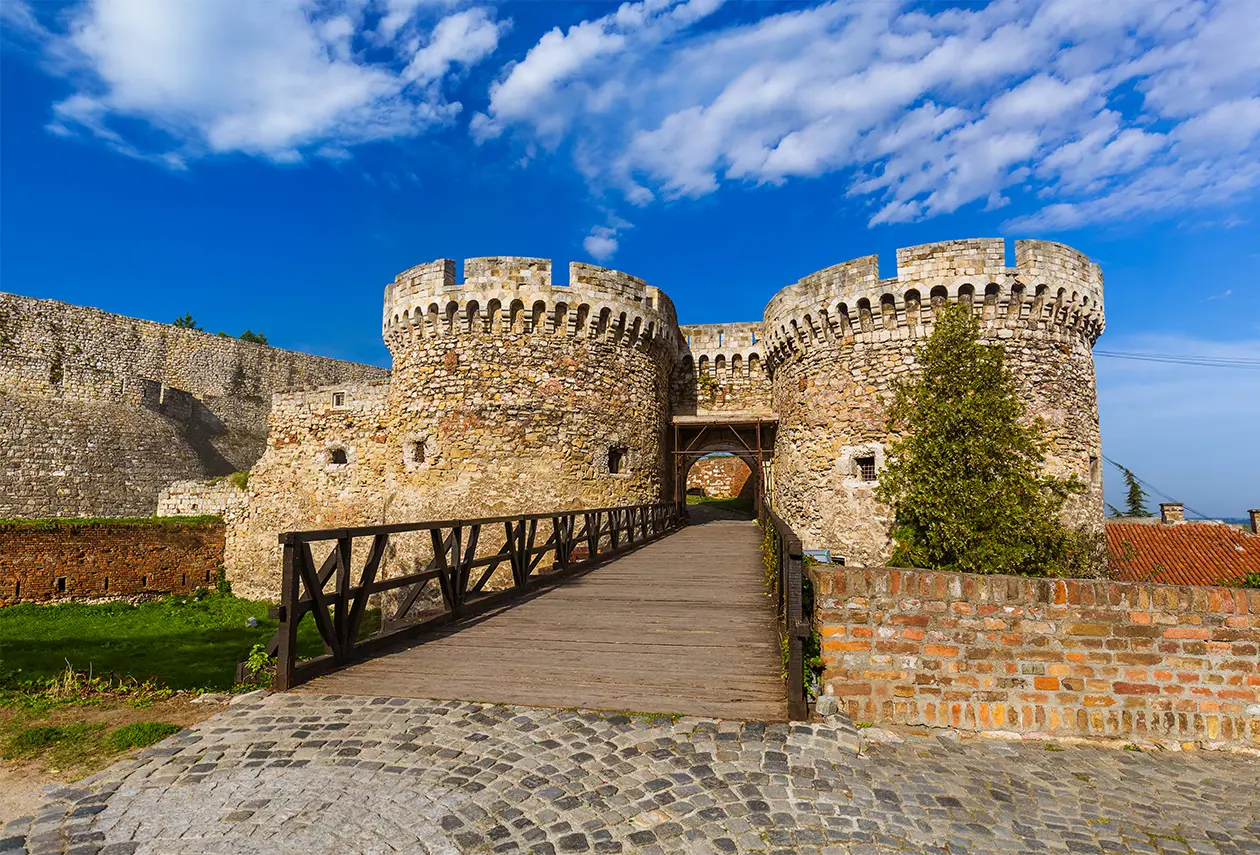
The ideal starting point to explore the city center is Republic Square (Trg Republike), the beating heart of Belgrade. In the square, you'll find the Monument to the Victor of Pergamon and the National Theatre. In another of Belgrade's oldest squares, Terazije Square, you can admire more historical buildings and the famous Hotel Moskva, a typical example of Art Nouveau architecture.
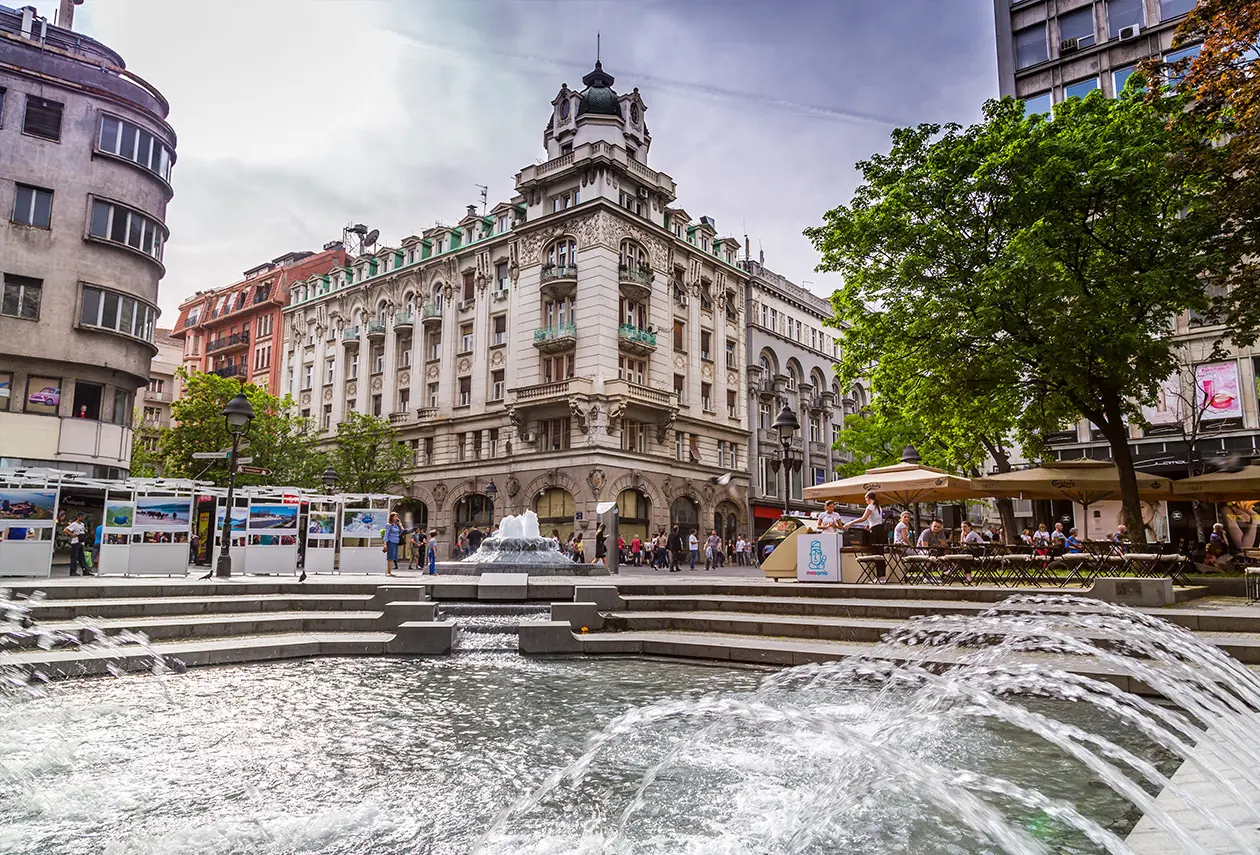
In the center of Belgrade, there are two significant architectural buildings representing the city's royal and administrative past: the Old Palace (Stari Dvor), the residence of the kings of Yugoslavia, and the neo-Renaissance-style City Hall.
The city's churches are also important, both as places of worship and as artistic masterpieces. Another symbol of Belgrade is the Cathedral of Saint Sava, one of the largest Orthodox churches in the world, with an impressive white and golden dome that stands out in the city skyline. Inside the cathedral, you can admire ornamentation of frescoes and mosaics, showcasing Orthodox religious art.
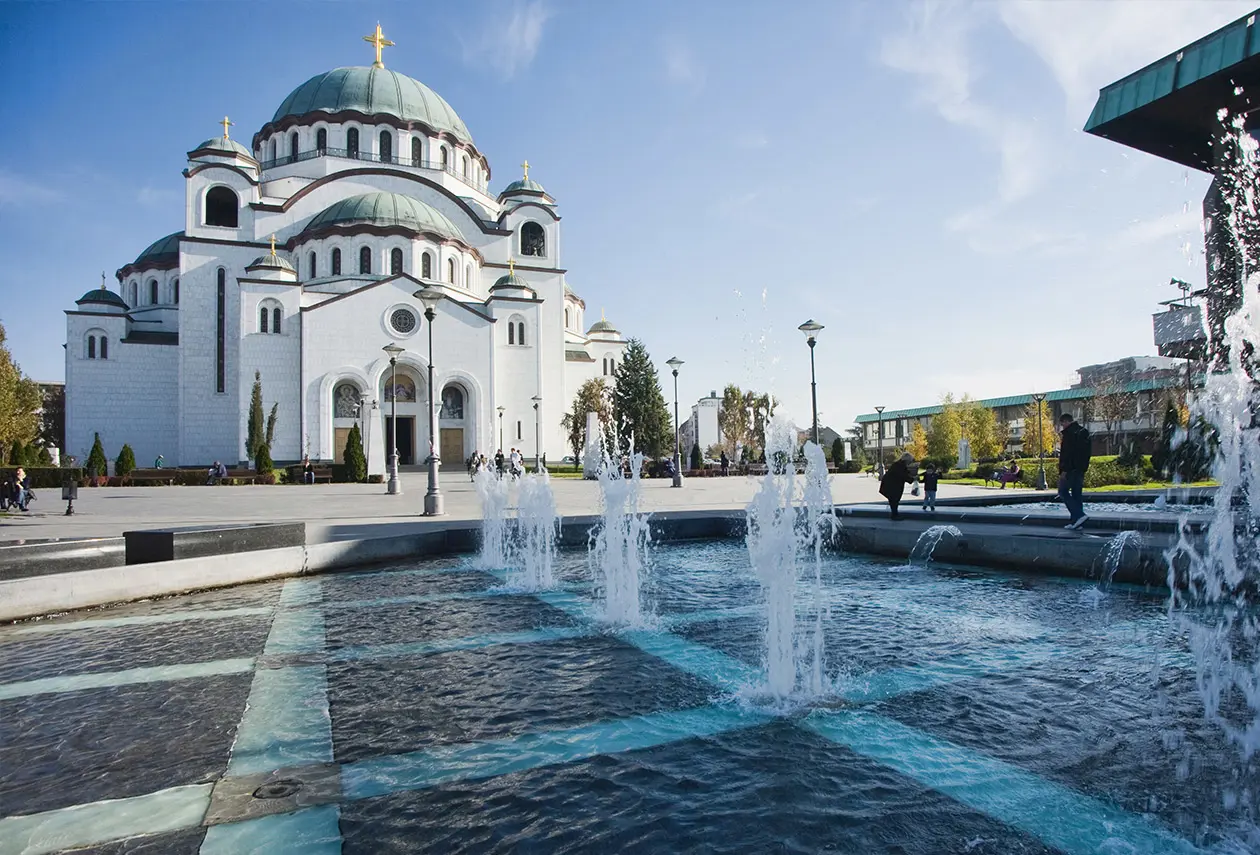
Also, worth a visit is the Church of Saint Mark, another Serbian Orthodox church with an eclectic design combining Serbian and Byzantine elements, featuring a colorful facade and intricate details inside. A crossroads of cultures and influences, Belgrade is characterized by a rich cultural and historical heritage that is reflected even in its museums, such as the National Museum, the Museum of Contemporary Art, and the Nikola Tesla Museum.
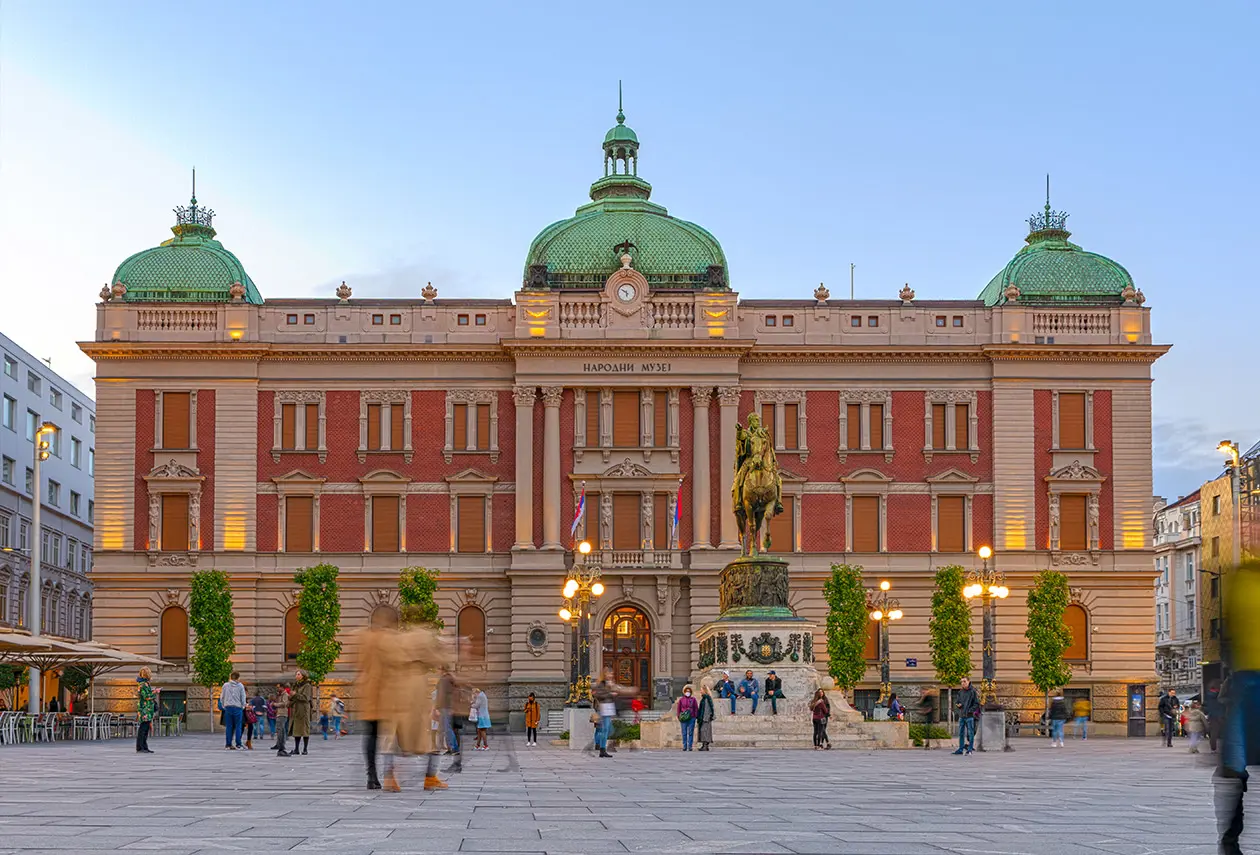
Belgrade Photo Copyright © Sisterscom.com, Depositphotos
The most famous museum in Belgrade is the National Museum of Serbia, located in the city center on the main square called Trg Republike. This museum offers an extensive collection of Serbian art and historical artifacts covering millennia of history. The exhibits include artworks, ancient artifacts, and archaeological findings, providing a comprehensive overview of Serbian culture and history.
Meanwhile, the Museum of Contemporary Art, founded in 1965, based its exhibition policy on representing relevant artists and trends in 20th-century Yugoslav, Serbian, and international art. Don't miss Savamala, a district on the banks of the Sava River where you can admire works by famous Serbian and foreign writers.
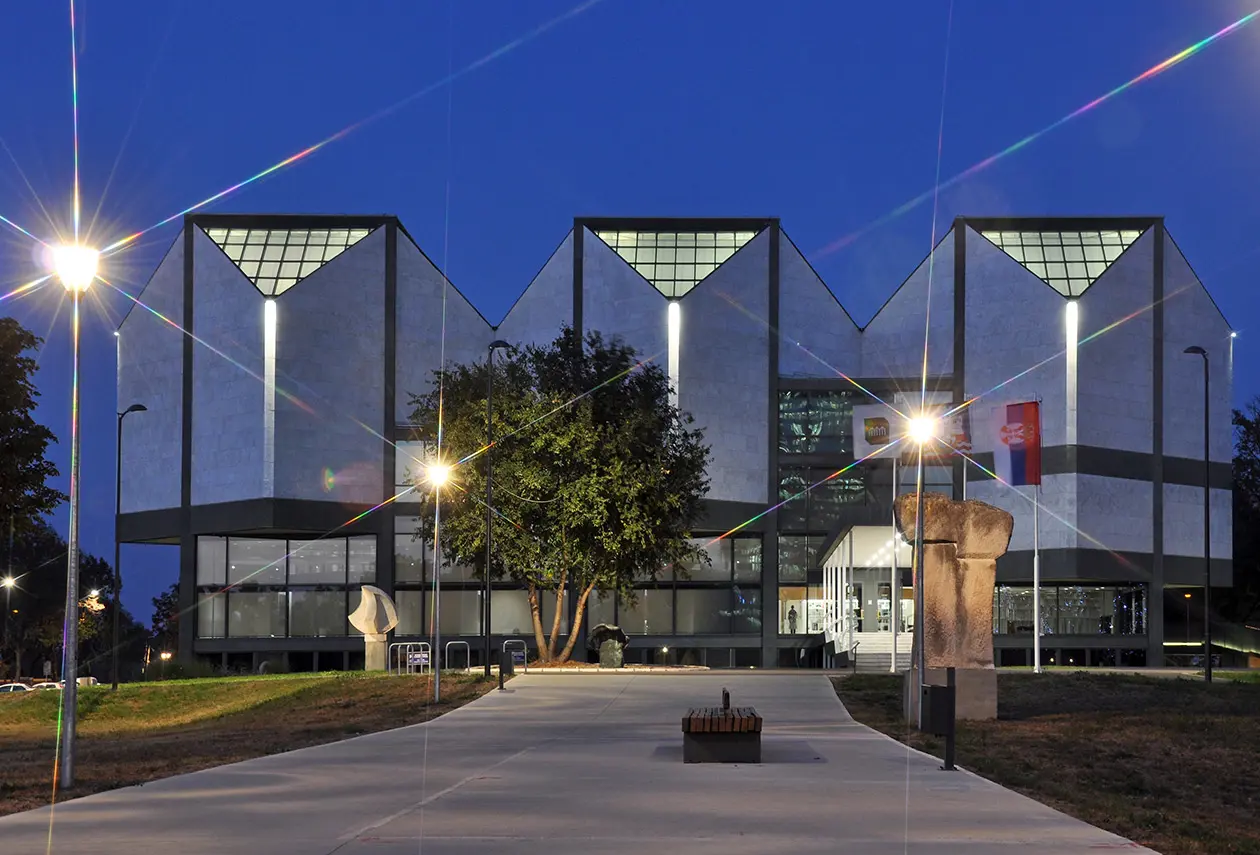
UNESCO's "Memory of the World" list includes the Nikola Tesla Museum in Belgrade, dedicated to the Serbian-American scientist Nikola Tesla. The museum houses his archive, including documents, manuscripts, photographs, drawings, books, and more.
In vibrant Belgrade, various events take place throughout the year to cater to different passions. For classical music enthusiasts, there are performances by the Belgrade Philharmonic Orchestra, while modern theater enthusiasts can enjoy BITEF, the Belgrade International Theatre Festival held in September. In April, there's the Belgrade Dance Festival, and there are also film festivals and sporting events, from traditional marathons and half-marathons to various water sports such as canoeing or kayaking, and major international events in European and world basketball, handball, water polo, or volleyball.
Serbian Cuisine and the Flavors of Belgrade
Serbian cuisine, while influenced by neighboring Balkan and European countries, boasts authentic dishes that can be discovered not only in Belgrade but throughout the entire territory. Depending on the region, you'll encounter different dishes, mainly based on pasta or meat.
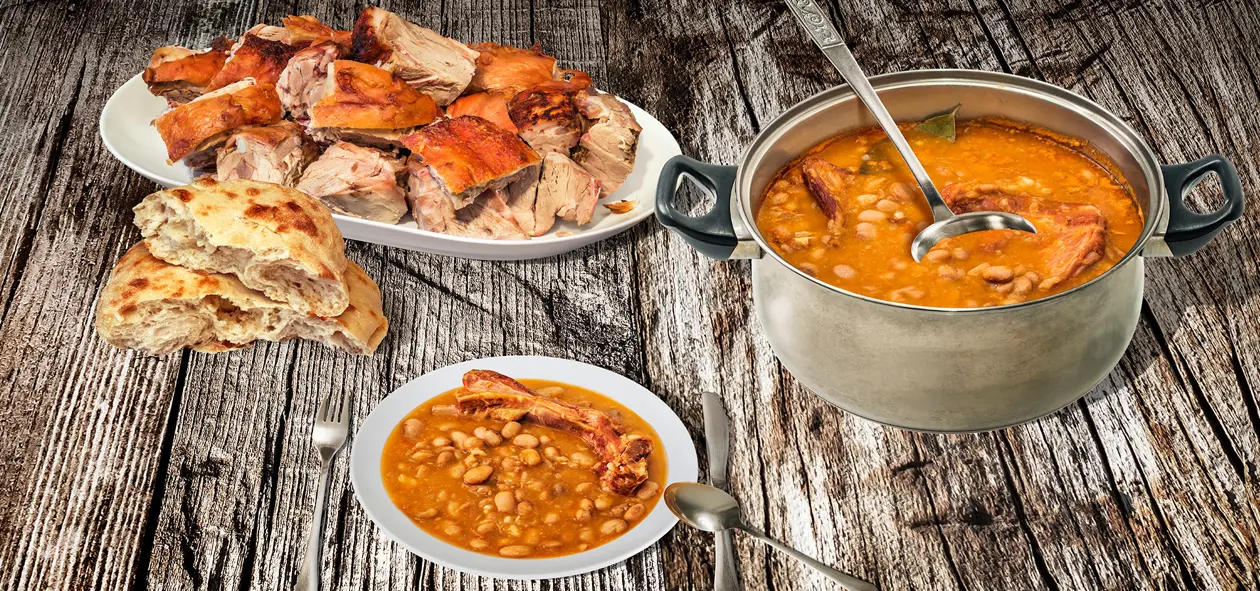
In the northern part of the country, dishes are characterized by pasta and various doughs. In central Serbia, you can savor "pita" (a savory pie made with filo pastry), roast pork, dried meat, and lamb. In the eastern regions, the most exquisite dishes include polenta, lamb boiled in milk, and "pita secca del pastore." In the south, grilled meats with fresh vegetables are a culinary delight. In the territory of Kosovo and Metohija, you'll find specialties like "bingur", turkey, and various dishes cooked with lamb and sheep. Everywhere in the country, including Belgrade, delightful aromas enhance the journey with irresistible flavors.
Belgrade's cuisine is a blend of Balkan, Mediterranean, and Austro-Hungarian influences. Meat takes center stage on the Serbian table, followed by vegetables and cheese. The discovery of local gastronomy secrets begins with the traditional appetizer, which in Belgrade's restaurants (several of which hold Michelin recognition) is "proja" (cornbread) served with "kajmak" (traditional white cheese with cream).
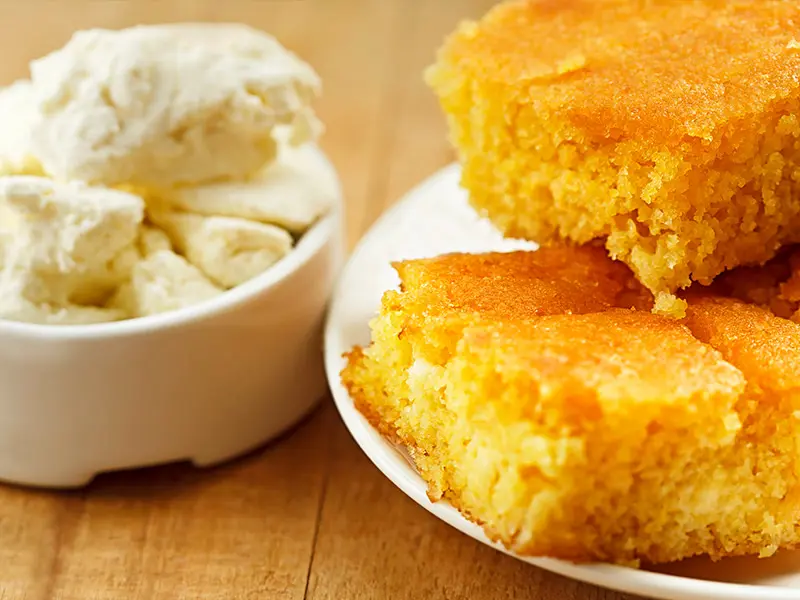
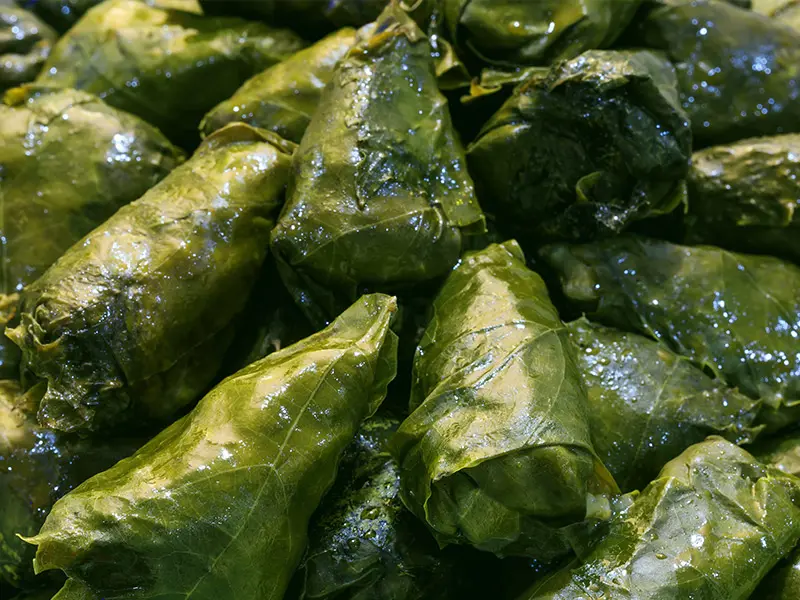
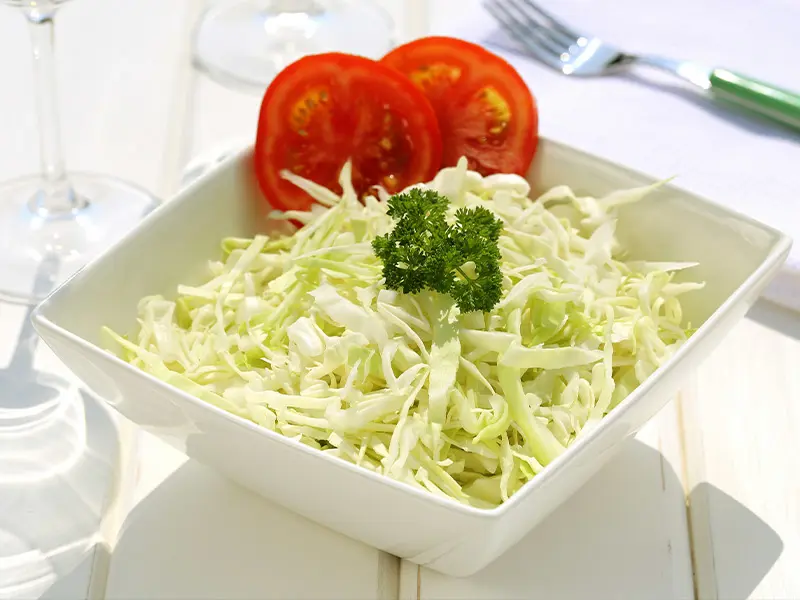
For those preferring lighter fare, the fresh "sarmice" (prepared with black onions and rice, all wrapped in cabbage leaves) is a must-try, along with winter sauerkraut salad. Also, do try "Ćevapčići," grilled minced meat patties made of beef, lamb, or pork, "roštilj" (grilled meat and vegetables), and "Pljeskavica", a giant hamburger often served with melted cheese and french fries.
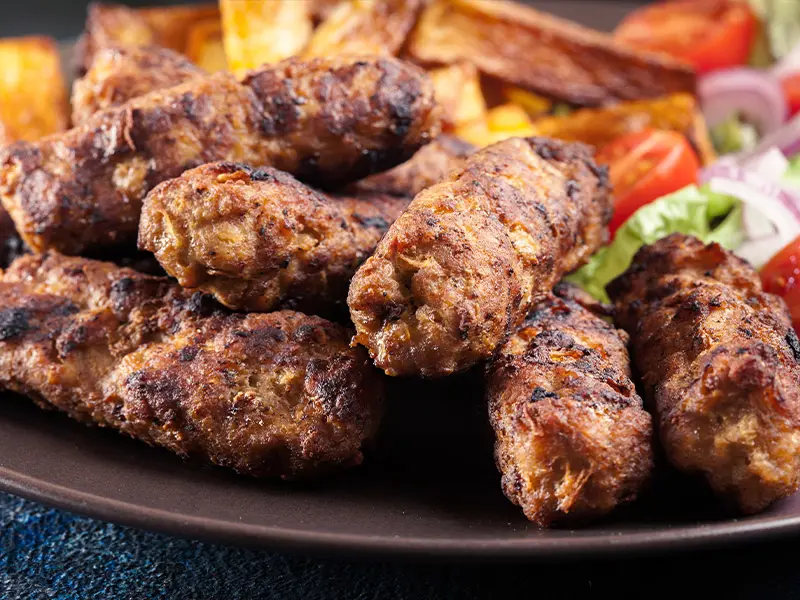
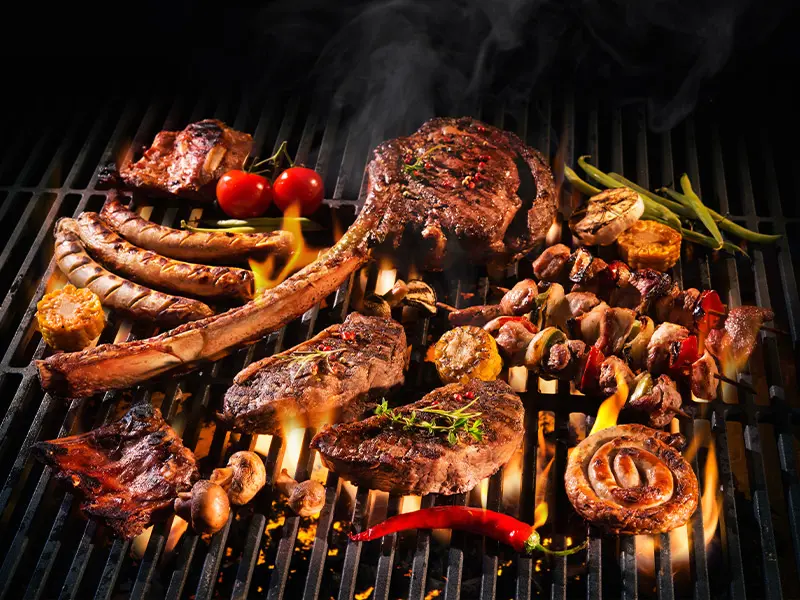

Among desserts, "Moskvašnit" stands out, created many years ago in the kitchens of the famous Hotel Moskva. You can also taste layered savory or sweet pie "pita" (prepared with very thin pastry and fillings of meat, cheese, vegetables, or fruits), pastries with plums, apples, cherries, and raspberries, "palačinke" - a type of crepe rolled and filled with fruit and chocolate, and "Baklava", sweet treats made of puff pastry, nuts, and honey.
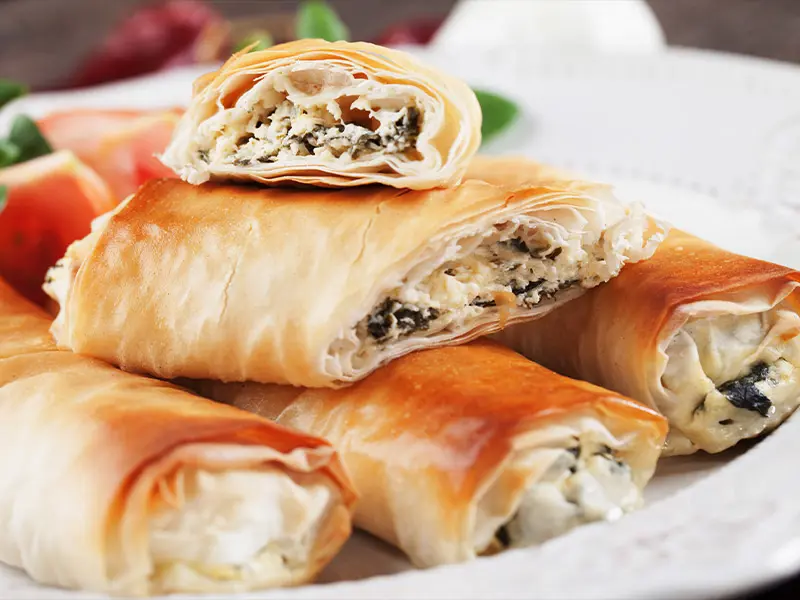
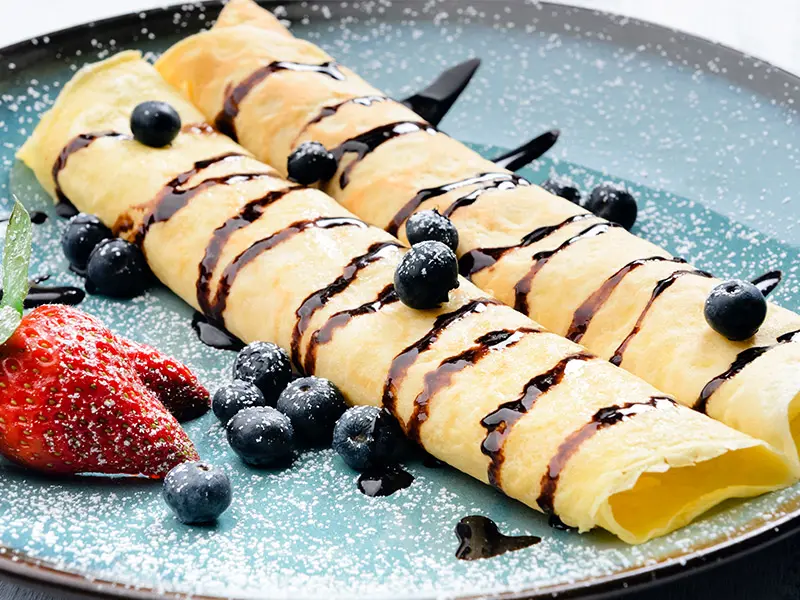
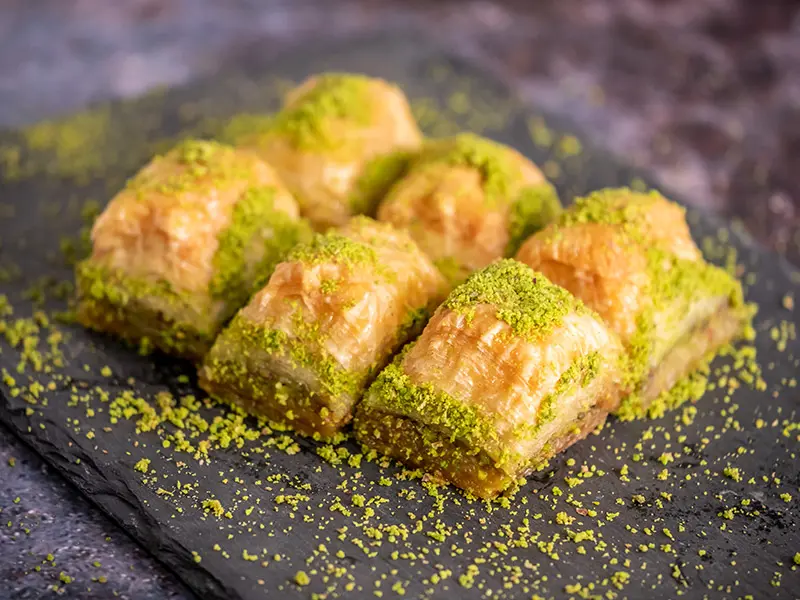
Skadarlija is Belgrade's most famous street where the bohemian atmosphere of the early 20th century city is revived, once inhabited by artists, actors, and writers. Here, you can listen to folk music while tasting traditional food. Dining with music is a popular custom in Belgrade. In various venues, you can enjoy typical Serbian wine and "rakija" (plum brandy) while savoring traditional dishes.
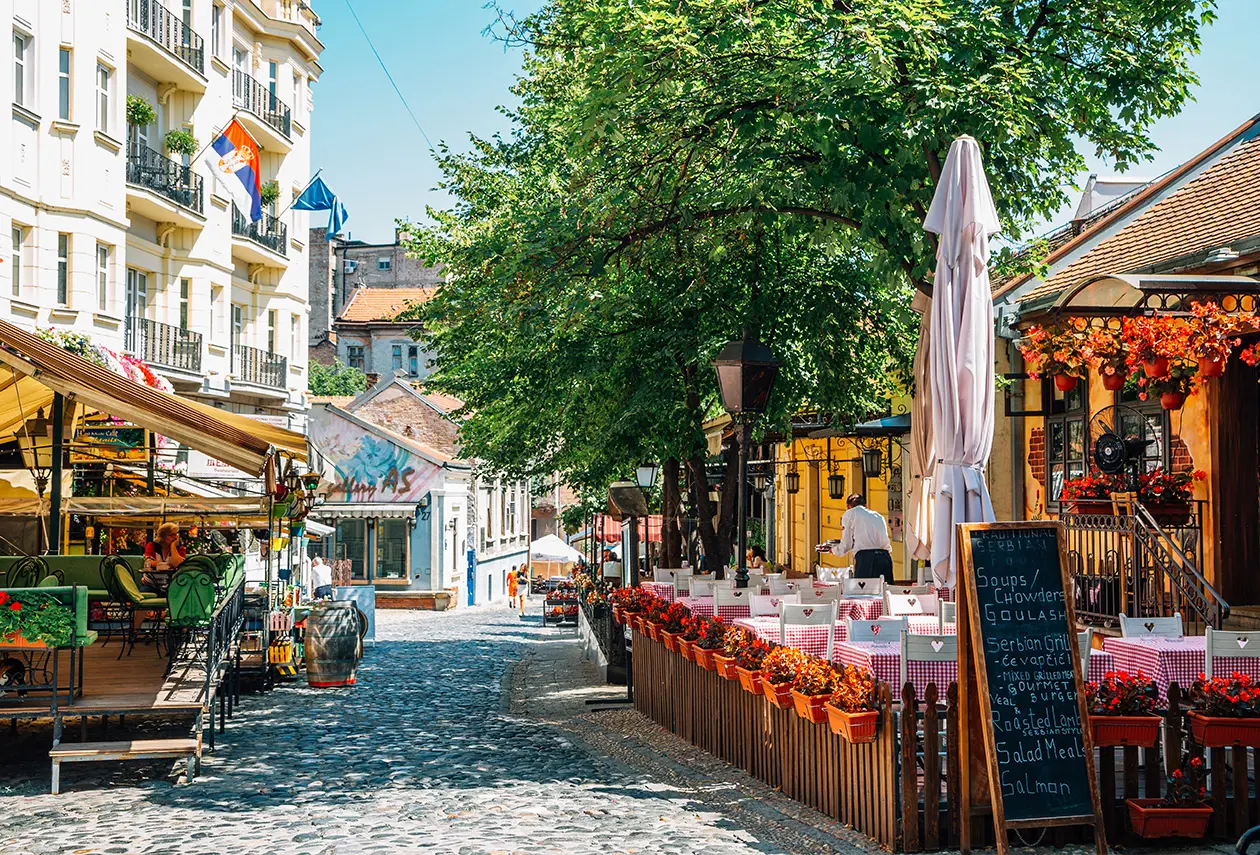
The riverside of Zemun and Novi Beograd represent Belgrade's centuries-old fishing tradition where you can taste fish specialties in restaurants along the Danube. Typical dishes to enjoy with Belgrade wines, made from grapes growing in vineyards next to the Danube and on the hills of Kosmaj and Avala.
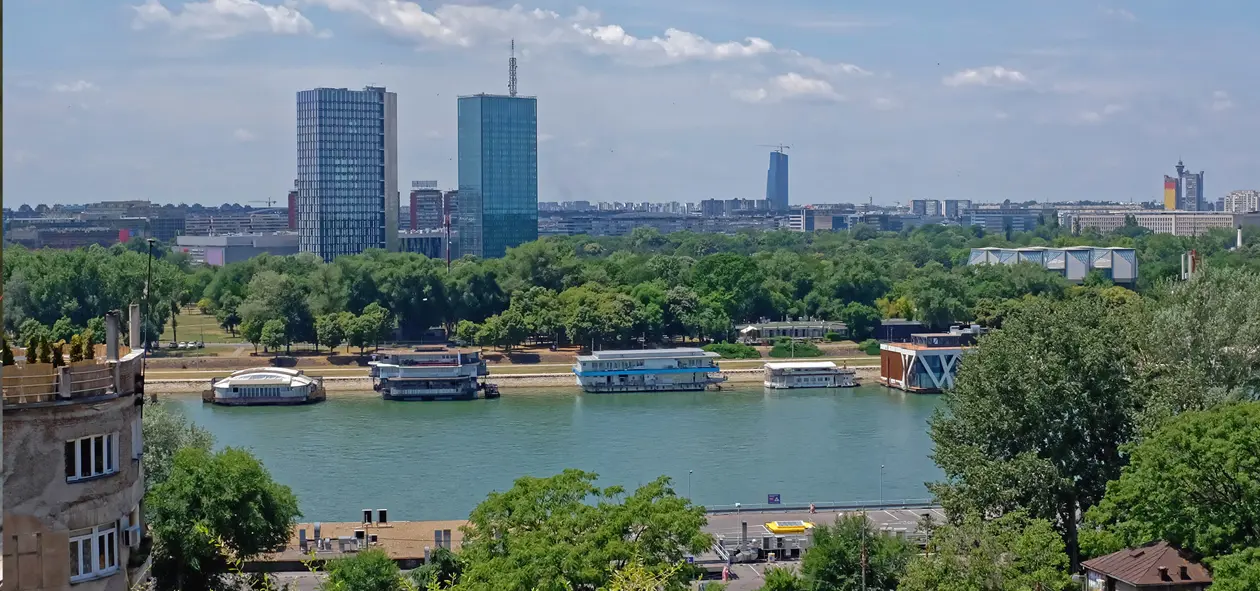
Another characteristic area of Belgrade to stop and taste Serbian cuisine is where the Sava and Danube rivers meet, a place of paths crossing parks, restaurants, and "splavovi", distinctive bars on rafts offering an enchanting view of the river and the city.
Text by: Alisè Vitri
Avion Tourism Magazine
Photos for editorial use only: Copyright © Sisterscom.com, Depositphotos
All rights reserved. Copyright © Sisterscom.com
Tourism Board
www.serbia.travel - www.beograd.rs
Partnership with Booking.com
Where to sleep in Belgrade
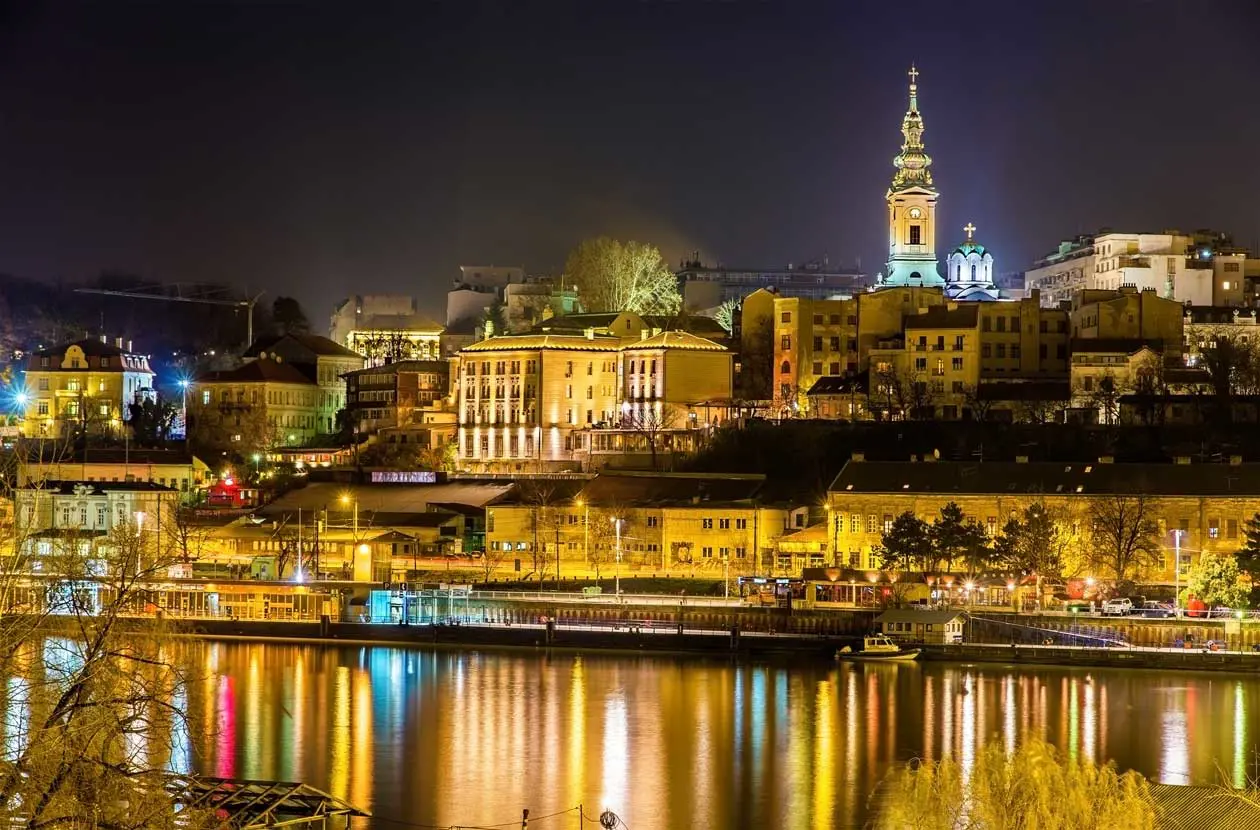
STARS
Hotels by stars, divided by the type of services offered:
HOUSES, B&Bs, HOSTELS
Stays in houses, B&Bs and hostels
DISTRICTS
Hotels in the districts
LANDMARKS
Hotel in tourist areas
LANDMARKS
Hotel in tourist areas
LANDMARKS
Hotel in tourist areas
WHERE TO GO IN BELGRADE
Monuments and tourist attractions in Belgrade
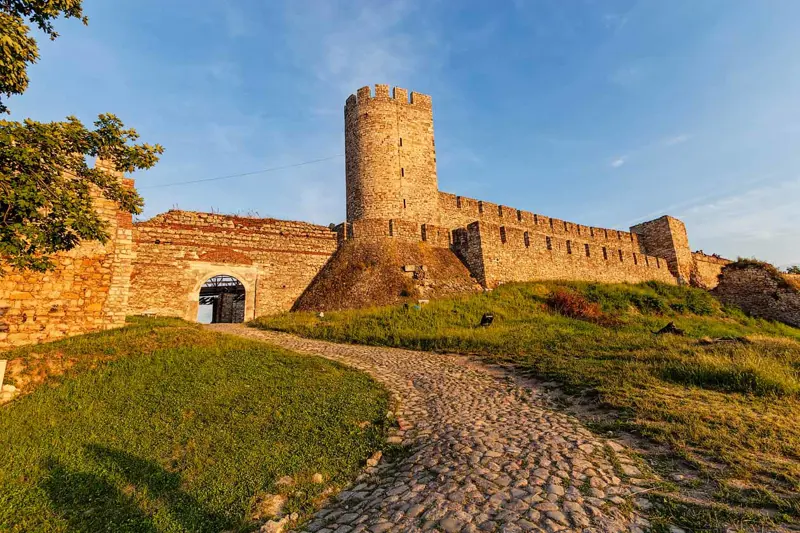
Photo Copyright © Sisterscom.com, Depositphotos
Belgrade Fortress
Belgrade Fortress with Kalemegdan is what remains of the former historical center of Belgrade. The complex consists of the Fortress, divided into the Upper City and the Lower City, and the Kalemegdan Park. It was built at the end of the 1st century AD. by the Romans as a military camp of the IV Flavian legion then destroyed several times by the Goths, the Huns, the Avars and the Slavs. It was then rebuilt over the centuries: above the Roman walls there are Serbian, Turkish and Austrian fortifications. At the end of the 18th century it obtained its definitive form. Knez Mihailova and Uzun Mirkova streets lead to the Fortress. The main gates of the Fortress are: Porta Stambol and Porta Sahat. The entrance to the medieval fortress was on the eastern side (near today's Zoo), through the Zindan Gate and the Upper Town Despot's Gate. Access to the Lower Town is from Bulevar Vojvode Bojovića (Vidin Gate) and Karađorđeva Street (Dark Gate).
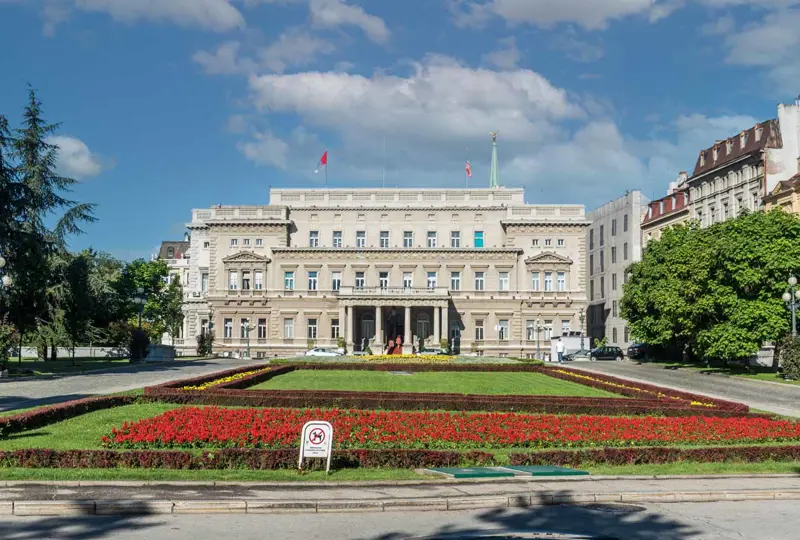
Copyright © Sisterscom.com, Depositphotos
Old Palace in Belgrade
Old Palace, the Royal Palace of the Obrenović dynasty of Serbia, is the seat of the Municipality of Belgrade and is located between Kralja Milana and Dragoslava Jovanovića streets. Built between 1882 and 1884 to a design by Aleksandar Bugarski in the style of 19th century academicism, it is linked to the political power of the Obrenović dynasty. Between 1903 and 1914, it was the residence of the Karadjordjević dynasty. Damaged during World War I and the bombing of Belgrade (1941), it has a classic design with a façade overlooking the garden and Kralja Milana street full of caryatids. From the Central Hall you enter the Red Hall where the "Portrait of a Girl" from 1862 by Đura Jakšić and the painting "Crossing the Neretva River" by Ismet Mujezinović are kept. In the Yellow Hall there are paintings (by Sava Šumanović, Jovan Bijelić, Petar Lubarda, Miodrag-Bata Mihajlović, Ljuba Lah and other artists) and wooden sculptures by Rista Stijović.
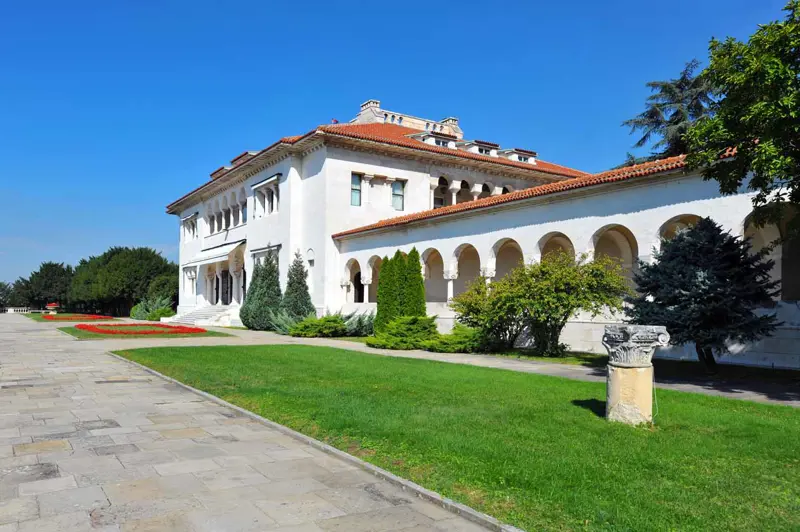
Copyright © Sisterscom.com, Depositphotos
Royal Palace in Belgrade
The Royal Palace of Belgrade is located on Dedinje Hill, the most exclusive part of the city with embassies and villas. The palace, in Serbian and Byzantine style, was built by King Alexander Karađorđević I (for Queen Mary, Roman princess and granddaughter of Queen Victoria, Queen of Great Britain) between 1924 and 1929 based on a design by the architect Živojin Nikolić and the scholar Nikolai Krasnova. The ceremonial hall is decorated with frescoes, copied from the Dečani and Sopoćani monasteries of the Middle Ages. Today it is the home of Alexander Karađorđević II, heir to President Tito.
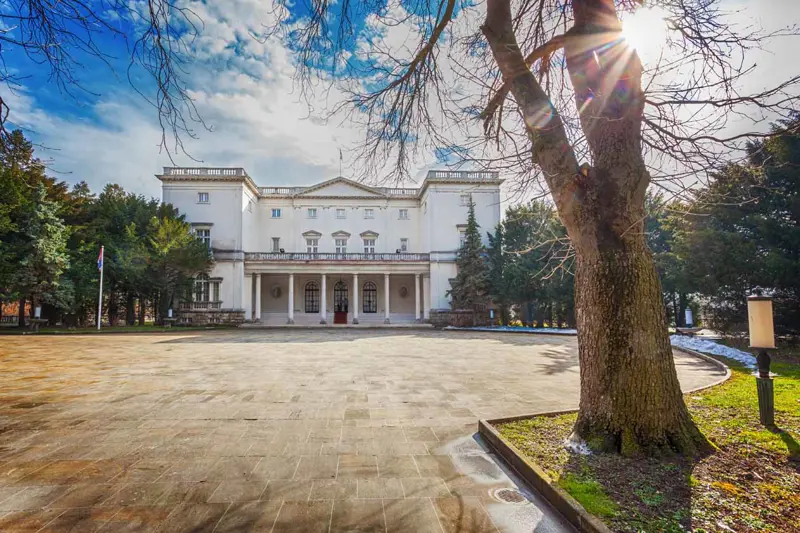
Copyright © Sisterscom.com, Depositphotos
White Palace in Belgrade
The Old Palace building was built between 1934 and 1936 according to the design of architect Alexander Đorđević, in neoclassical style, as the residence of the children of King Alexander Karađorđević I. The elegant building has a simple aesthetic and, on its floor lower, has a large entrance hall for ceremonial use, several rooms furnished with Louis XV and Louis XVI style furniture, a royal dining room and a library. The walls of the White Palace are decorated with a rich collection of paintings created by well-known artists.
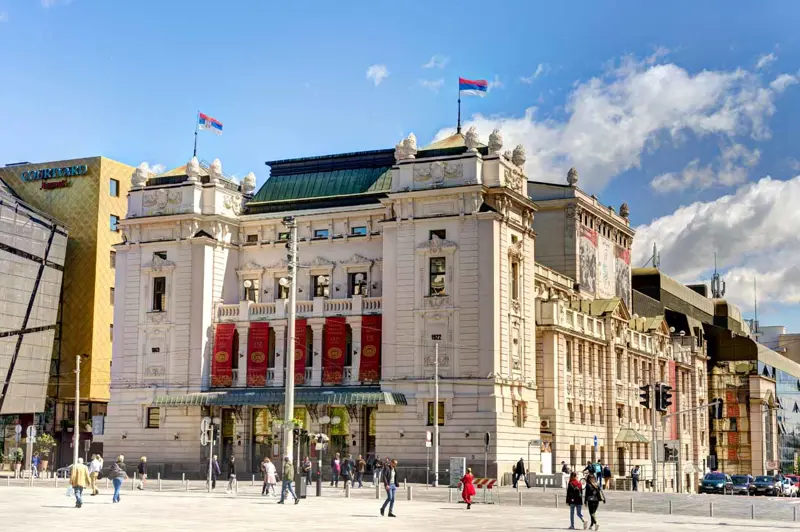
Copyright © Sisterscom.com, Depositphotos
National Theatre in Belgrade
The National Theatre in Belgrade was commissioned by Knez Mihailo Obrenović and built in 1869 to a design by the architect Aleksandar Bugarski. The theater building of the time was reminiscent of the Teatro alla Scala in Milan, due to its Renaissance concept and decorative finishes. Subsequent reconstructions modified its original appearance and in 1986 the theater regained its 1922 appearance and an annex was built on Braće Jugovića Street. In addition to theatrical purposes, the hall was used for charity balls and concerts during the 19th century. In this building the Great Constitutional Assembly adopted the Constitution of 1888.
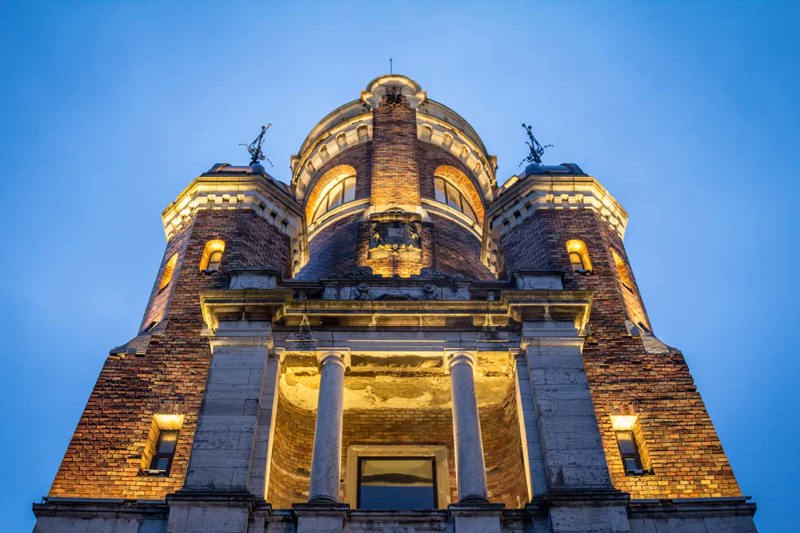
Copyright © Sisterscom.com, Depositphotos
Zemun
Zemun is a city within a city. The symbol of Zemun is the Millennium Tower on Gardoš Hill, in the central part of the oldest preserved fortress from the 14th century. The Tower, known as Janos Hunyadi Tower, is open every day and you can admire the balcony with lookout and the panoramic view of the city. The historic center of Zemun has narrow streets and old buildings from the period of Austro-Hungarian rule. There are several restaurants offering traditional local dishes and fish specialties where you can stop to eat and then take a walk along the Danube bank to listen to traditional folk music.
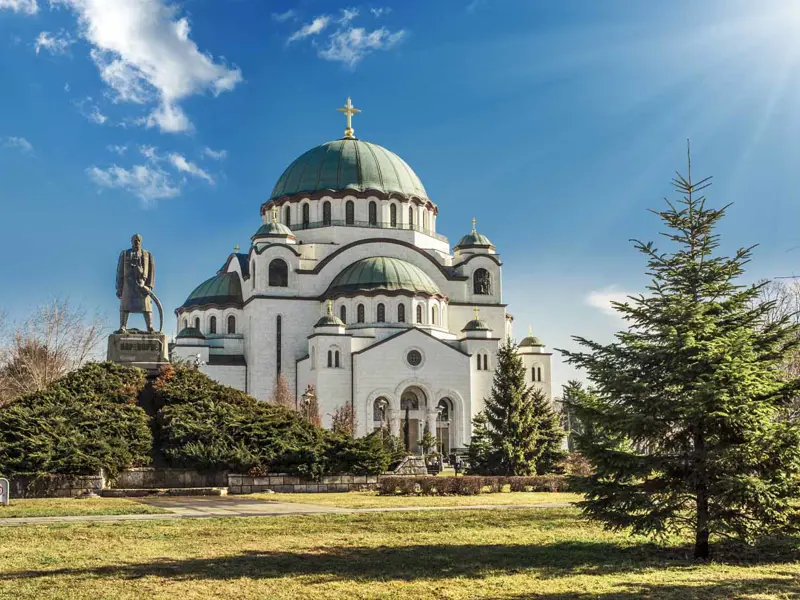
Copyright © Sisterscom.com, Depositphotos
Church of Saint Sava in Belgrade
St. Sava Church is one of the largest Orthodox churches in the world built on Vračar Hill in Belgrade. Right here, as legend has it, during Turkish rule the remains of Saint Sava, the most important Serbian saint, first archbishop and founder of the 13th century Serbian Orthodox Church, were burned. Here you can also admire the monument to Karađorđe in front of the church, a fountain and the building of the National Library of Serbia, which houses the largest collection of books in the Balkans.
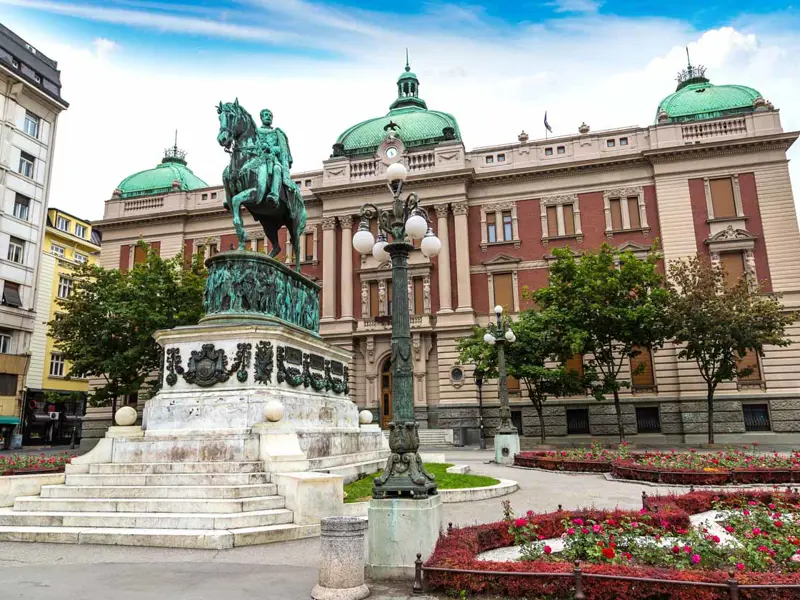
Copyright © Sisterscom.com, Depositphotos
Republic Square in Belgrade
Republic Square is the ideal starting point for a city tour because it is surrounded by historic buildings such as the National Theatre, the Reunion Palace which houses the Boško Buha Theatre, and the monumental building of the National Museum. In the center of the square you can admire the monument to Prince Mihailo Obrenović, a work by the Venetian sculptor Enrico Pazzi dating back to 1882 in memory of the prince who improved the economic and cultural life of Serbia who was then assassinated in 1868. Concerts and events are also held in the square and it is a meeting place for citizens.
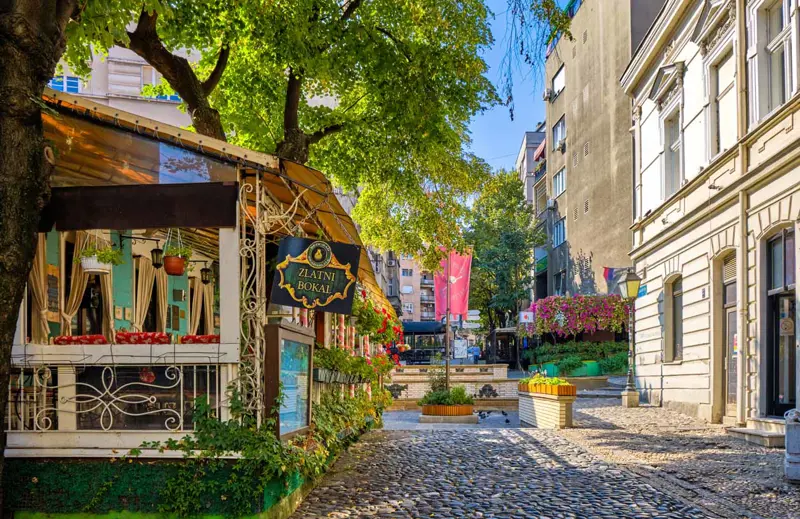
Copyright © Sisterscom.com, Depositphotos
Skadarlija neighborhood of Belgrade
In Skadarlija you can feel the atmosphere of the bohemian Belgrade of the past. In fact, Skadarlija was the bohemian part of the city at the beginning of the 20th century where actors, writers and painters moved and met in Skadarlija taverns. Here is the house of the Serbian writer and painter Đura Jakšić, a meeting point for poets. This neighborhood of Belgrade, with its cobbled street, is compared to Montmartre in Paris for its artistic look and atmosphere. Today, in the restaurants of Skadarlija you can enjoy traditional specialties to the sound of traditional folk music.
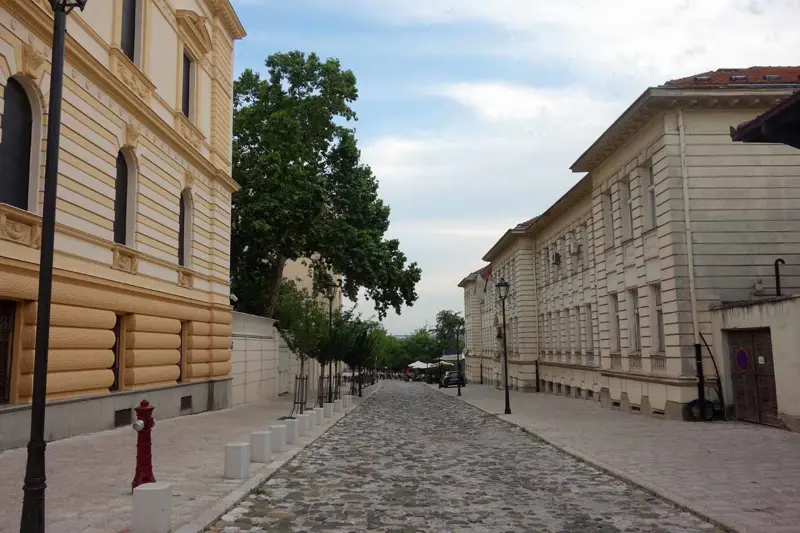
Copyright © Sisterscom.com, Depositphotos
Kosančićev venac neighborhood in Belgrade
Kosančićev venac retains the 19th century atmosphere with cobbled streets, gardens and old-fashioned buildings. In the neighborhood there are cafes overlooking the river and wineries. Ancient structures were built in both Balkan and Oriental styles such as the Residence of Princess Ljubica and the oldest tavern in Belgrade offering traditional Serbian cuisine. In the vicinity of Kosančićev venac is the Orthodox cathedral and Patriarchal Palace, built in both Serbian and Byzantine styles, housing the Museum of the Serbian Orthodox Church.
Museums in Belgrade
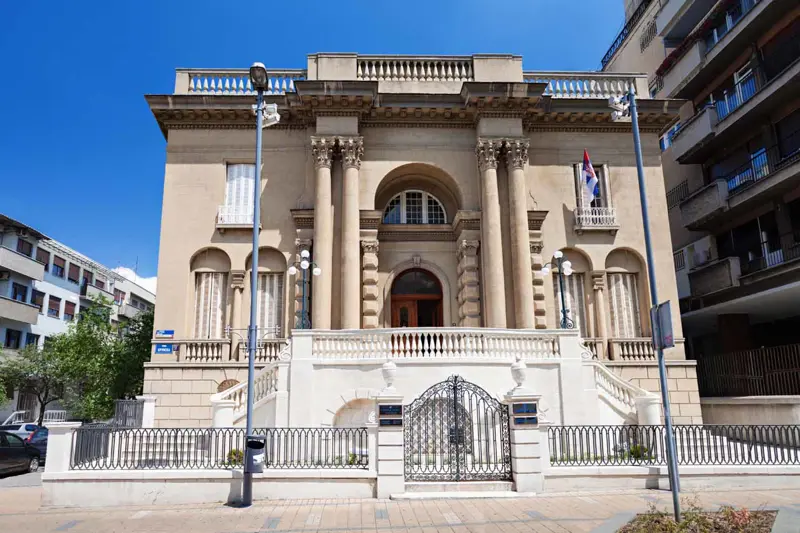
Copyright © Sisterscom.com, Depositphotos
Nikola Tesla Museum
The famous scientist Nikola Tesla is an American of Serbian origin and in the Nikola Tesla Museum in Belgrade his personal objects, manuscripts, photographs, drawings, books, inventions, documents and inventions such as Tesla pumps, tachometers, electrical measuring instruments, electrical devices, a static electricity eliminator and a cut cable from the Niagara Hydroelectric Power Plant. The Nikola Tesla Archive is listed in UNESCO's "Memory of the World" list.
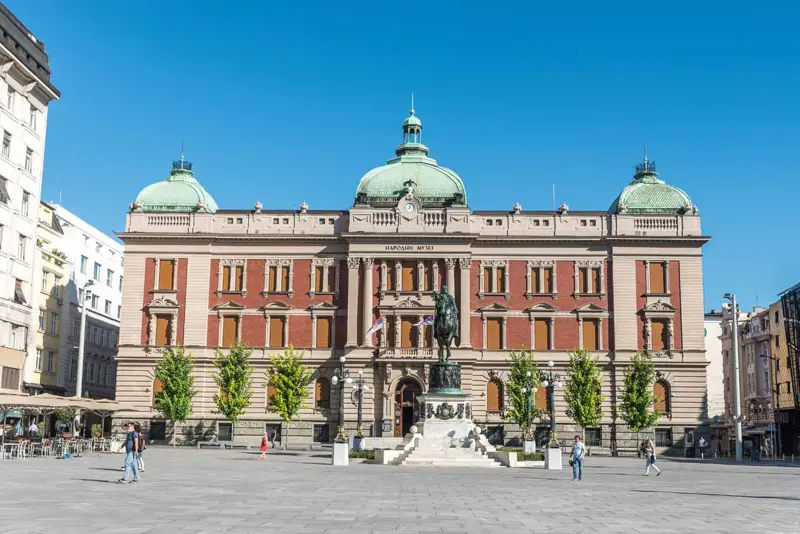
Copyright © Sisterscom.com, Depositphotos
National Museum of Belgrade
The National Museum of Belgrade, founded in 1844, is located in the Treasury building. It consists of the Fresco Gallery (Cara Uroša 20), the Vuk and Dositej Museum (Gospodar Jevremova 21) and the Nadežda and Rastko Petrović Memorial Museum (Ljube Stojanovića 25). It houses archaeological collections, medieval art, 8th and 20th century painters, numismatics as well as the Miroslavljevo Jevanđelje (Gospel of Miroslav), an ancient Cyrillic manuscript created around 1190.
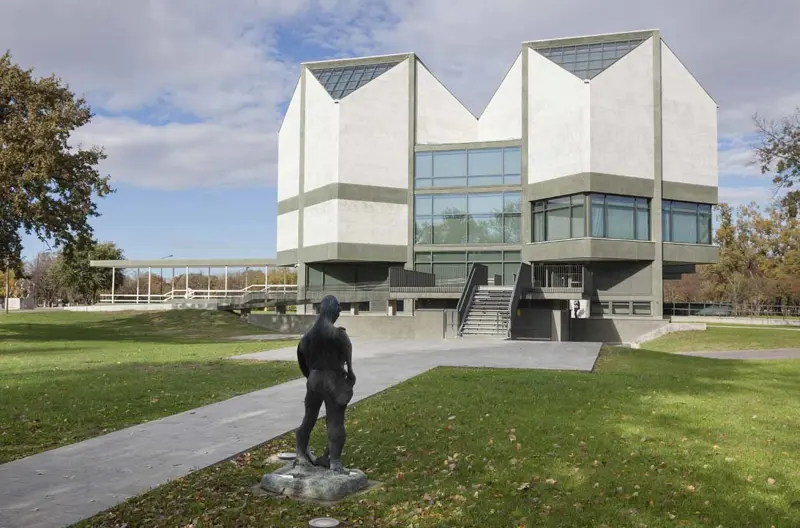
Copyright © Sisterscom.com, Depositphotos
Museum of Modern Art in Belgrade
The Belgrade Museum of Modern Art, established in 1958, is characterized by the Petar Dobrović Gallery (Kralja Petra I 36) and the Petar Lubarda Atelier (Iličićeva 1), the Gallery Bequest of Milica Zorić and Rodoljub Čolaković (Drajzerov prolaz 2 ) and Salon MSU (Pariska 14). It houses works by Yugoslavian painters, sculptors and graphic artists of the 20th century. In addition to the painters, the permanent collection exhibits several sculptures by Yugoslav artists. The museum also displays temporary exhibitions of modern and contemporary artists.
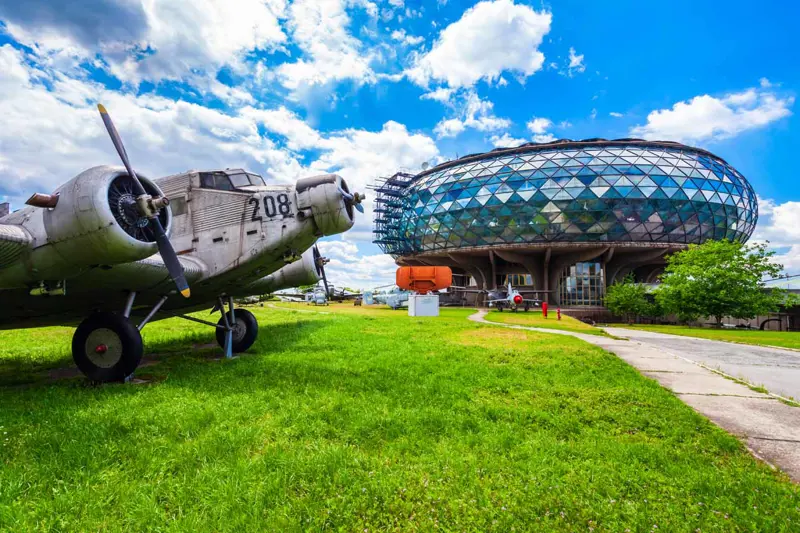
Copyright © Sisterscom.com, Depositphotos
Belgrade Aviation Museum
The Belgrade Aviation Museum was established in 1957 by the War Aviation and Air Defense Command. In the museum you can admire various types of aircraft, engines, equipment, commemorative collections of particular pilots, models and teaching aids. The distinctively designed museum building is located on the plateau opposite Belgrade Airport in Surčin. The museum offers interesting ideas for enthusiasts of aircraft, airplane engines, industry and aviation professions.
Partnership with GetYourGuide
Excursions in Belgrade and surroundings
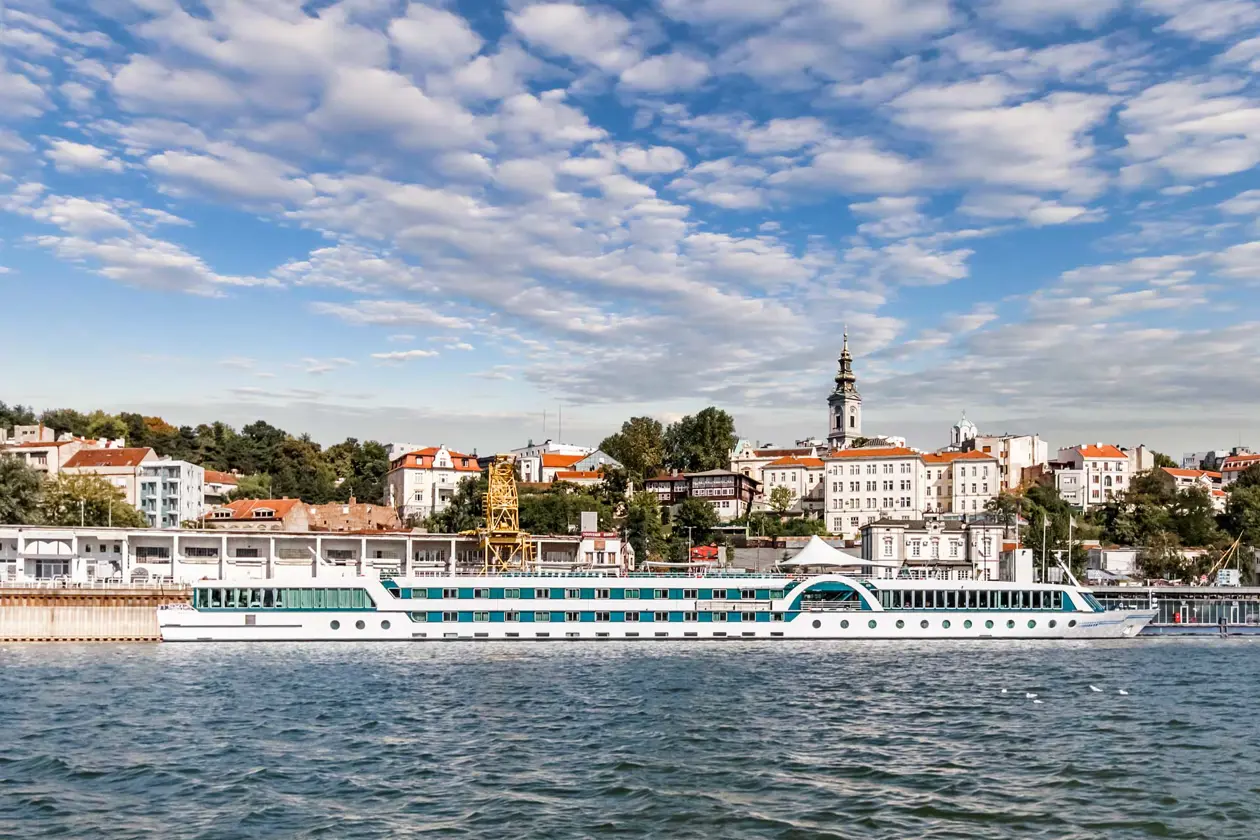
Belgrade. Copyright © Sisterscom.com, Depositphotos
River cruise in Belgrade
Ride along the Sava and Danube rivers on a boat cruise in Belgrade with expert guide and sail along the Great War Island on the way to Zemun with the Millenium tower. You admire the view of the Belgrade Fortress, the new Belgrade Waterfront area and its new Belgrade Tower. The cruising time on the boat is 1.5 hours and the whole tour time is 2 hours (meeting with the tour guide, boarding and disembarking). Reservation with free cancellation up to 24 hours before. Information and reservations: River cruise in Belgrade.
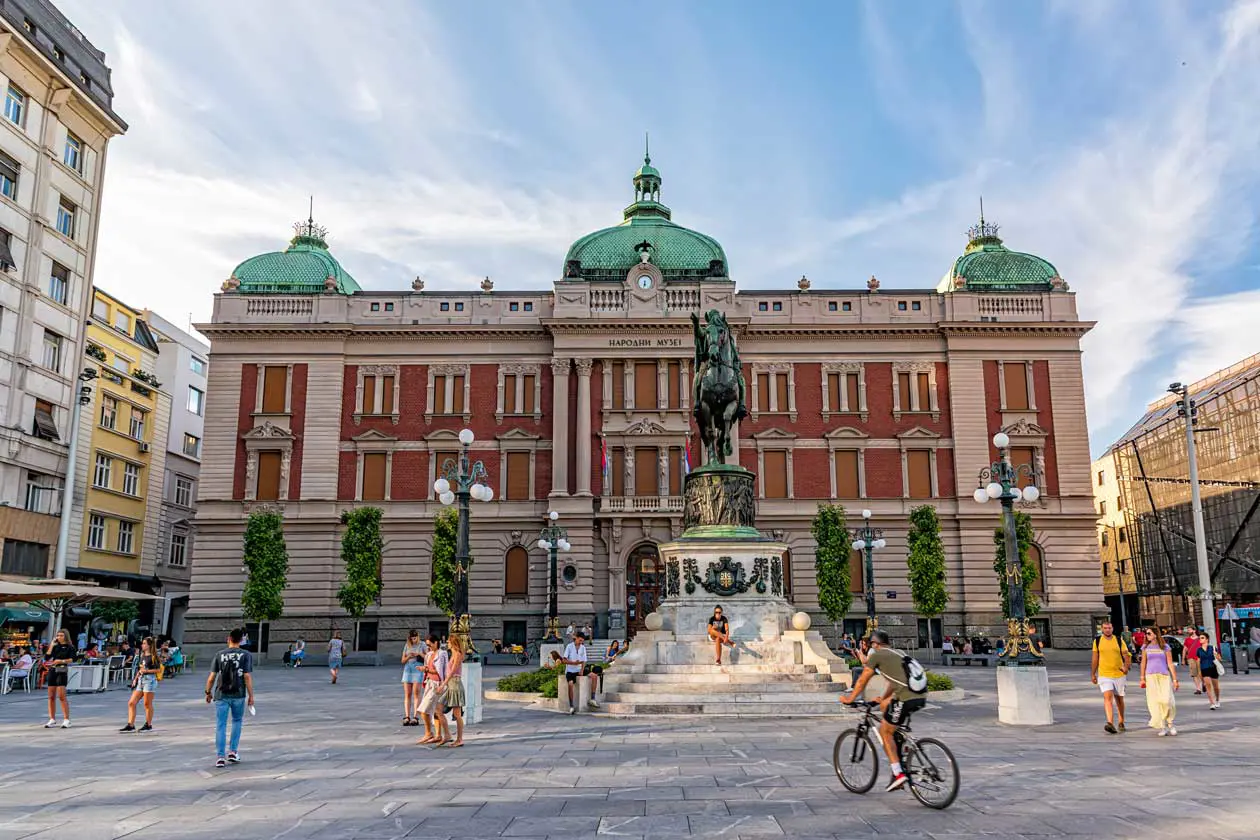
Belgrade, Republic square. Copyright © Sisterscom.com, Depositphotos
Tour of Belgrade and its neighborhoods
Shared or private tour, by car and on foot, to discover the main attractions of the city and the neighborhoods of Belgrade: Kalemegdan, Belgrade Fortress, Zemun, Upper Town, New Belgrade, Gazela Bridge, Dedinje, Topčider Hill, the House of Red Star of Belgrade, Avala (green mountain of Belgrade less than 20 km from the city center), the highest point of Avala with the Monument to the Unknown Hero, Avala tower, Vračar area with the Church of St. Sava (Saint Sava Temple), Slavija Square, Nemanjina Street, Parliament Building and Republic Square, where the tour ends, and is the heart of Belgrade. Reservation with free cancellation up to 24 hours before. Information and reservations: Tour of Belgrade and its neighborhoods.
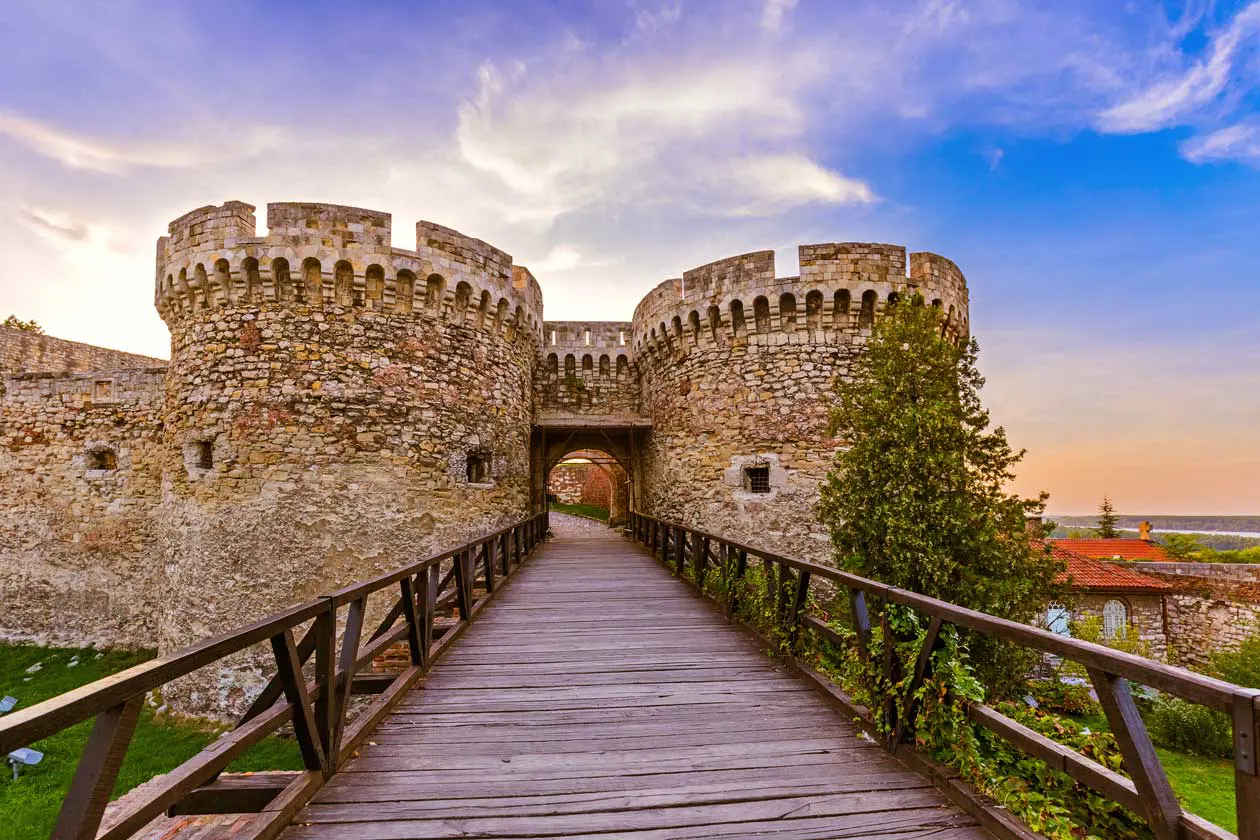
Belgrade fortress. Copyright © Sisterscom.com, Depositphotos
Belgrade Fortress Underground Tour and Wine along the Sava River
Guided sightseeing tour of Belgrade Fortress and visit to the underground sites of the fortress. Admire the Roman well (built by the Austrians in the 18th century), the Cold War military bunker and the gunpowder depot with the Roman lapidarium and Roman finds from Serbia. The tour ends with a glass of local wine at Beton Hala, a former industrial warehouse on the bank of the Sava River later transformed into an eating and drinking space. Reservation with free cancellation up to 24 hours before. Information and reservations: Belgrade Fortress Underground Tour and Wine along the Sava River.
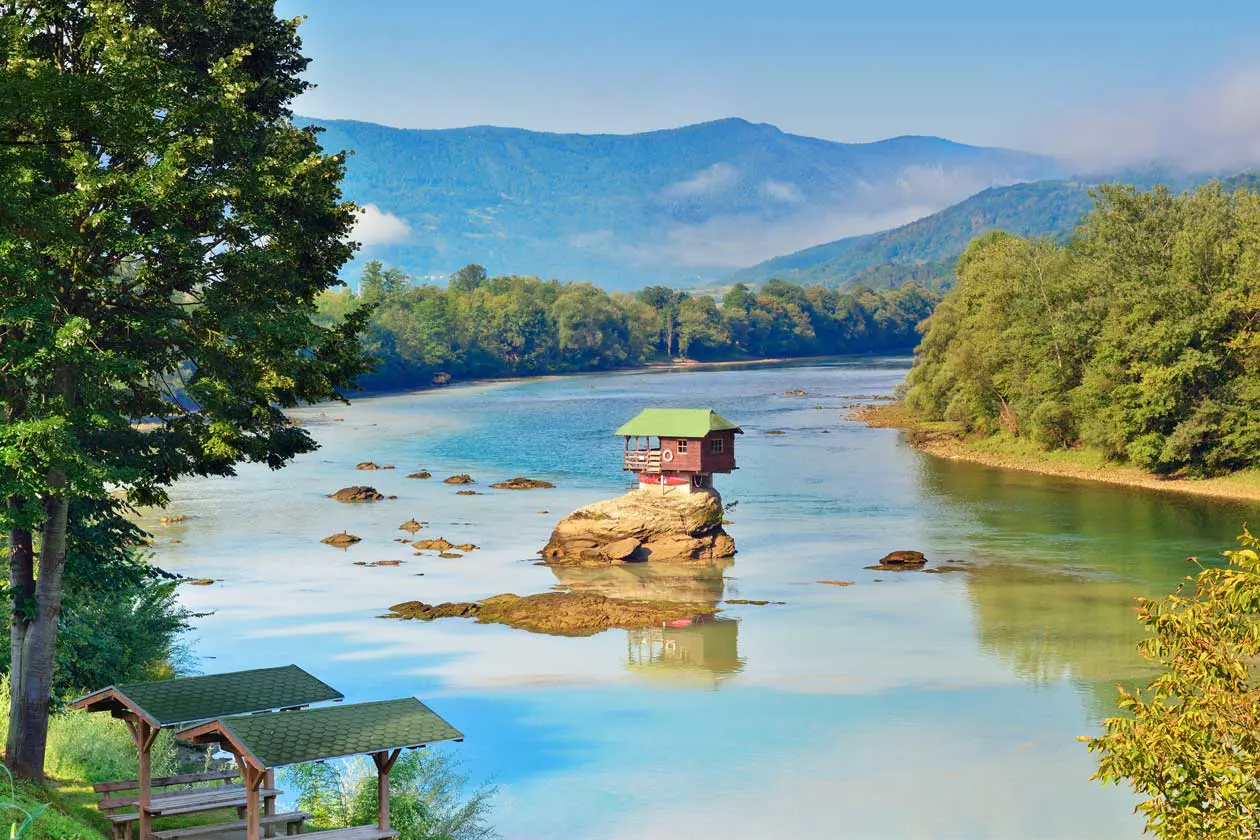
House on the Drina river, Serbia. Copyright © Sisterscom.com, Depositphotos
Western Serbia: visit the main sites with a day tour from Belgrade
Tour from Belgrade to the countryside of western Serbia in the wild and uncontaminated nature. 2-hour tour to see: a viewpoint, Bajina Bašta (small town at the foot of Mount Tara) with the house on the Drina river, the Šargan Eight train in a narrow 1925 railway, train ride and viewpoints in Mokra Gora. After the train, the journey continues to Mećavnik (known as the "wooden city") then stop for a traditional lunch and return to Belgrade in the afternoon. Reservation with free cancellation up to 24 hours before. Information and reservations: Western Serbia: visit the main sites with a day tour from Belgrade.
Discover all tours and excursions
News & Useful info
You might be interested in
Other destinations
Airports nearby Belgrade







